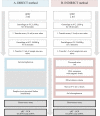Quantification of circulating cell-free DNA (cfDNA) in urine using a newborn piglet model of asphyxia
- PMID: 31891615
- PMCID: PMC6938324
- DOI: 10.1371/journal.pone.0227066
Quantification of circulating cell-free DNA (cfDNA) in urine using a newborn piglet model of asphyxia
Abstract
Cell free DNA (cfDNA) in plasma has been described as a potential diagnostic indicator for a variety of clinical conditions, including neonatal hypoxia. Neonatal hypoxia or perinatal asphyxia is a severe medical condition caused by a temporary interruption in oxygen availability during birth. Previously, we have reported temporal changes of cfDNA detected in blood in a newborn piglet model of perinatal asphyxia. However, cfDNA can also be found in other body liquids, opening for a less invasive diagnostic prospective. The objective of this study was to test and establish a reliable method for the isolation and quantification of cfDNA from urine and to explore changes in the quantities of cfDNA using a newborn piglet model of asphyxia. Animals were exposed to hypoxia-reoxygenation (n = 6), hypoxia-reoxygenation + hypothermia (n = 6) or were part of the sham-operated control group (n = 6) and urine samples (n = 18) were collected at 570 minutes post-intervention. Two alternative applications of cfDNA measurement were tested, an indirect method comprising a centrifugation step together with DNA extraction with magnetic beads versus a direct assessment based on two centrifugation steps. CfDNA concentrations were determined by a fluorescent assay using PicoGreen and by qRT-PCR. Genomic (gDNA) and mitochondrial DNA (mtDNA) cfDNA were determined in parallel, taking into account potential differences in the rates of damages caused by oxidative stress. In contrast to previous publications, our results indicate that the direct method is insufficient. Application of the indirect method obtained with the fluorescence assay revealed mean cfDNA levels (SD) of 1.23 (1.76) ng/ml for the hypoxia samples, 4.47 (6.15) ng/ml for the samples exposed to hypoxia + hypothermia and 2.75 (3.62) ng/ml for the control animals. The mean cfDNA levels in piglets exposed to hypoxia + hypothermia revealed significantly higher cfDNA amounts compared to mean cfDNA levels in the samples purely exposed to hypoxia (p < 0.05); however, no significant difference could be determined when compared to the control group (p = 0.09). Application of the indirect method by qRT-PCR revealed mean cfDNA levels of mtDNA and gDNA at the detection limit of the technique and thus no reliable statistics could be performed between the observed cfDNA levels in the investigated groups. The methodology for detection and monitoring of cfDNA in urine has to be further optimized before it can be applied in a clinical setting in the future.
Conflict of interest statement
The authors have declared that no competing interests exist.
Figures



Similar articles
-
Temporal patterns of circulating cell-free DNA (cfDNA) in a newborn piglet model of perinatal asphyxia.PLoS One. 2018 Nov 26;13(11):e0206601. doi: 10.1371/journal.pone.0206601. eCollection 2018. PLoS One. 2018. PMID: 30475817 Free PMC article.
-
Assessing nuclear versus mitochondrial cell-free DNA (cfDNA) by qRT-PCR and droplet digital PCR using a piglet model of perinatal asphyxia.Mol Biol Rep. 2023 Feb;50(2):1533-1544. doi: 10.1007/s11033-022-08135-0. Epub 2022 Dec 13. Mol Biol Rep. 2023. PMID: 36512170 Free PMC article.
-
Impaired early neurologic outcome in newborn piglets reoxygenated with 100% oxygen compared with room air after pneumothorax-induced asphyxia.Pediatr Res. 2001 Jun;49(6):812-9. doi: 10.1203/00006450-200106000-00017. Pediatr Res. 2001. PMID: 11385143
-
Perinatal asphyxia: a clinical review, including research with brain hypothermia.Neonatal Netw. 2001 Apr;20(3):31-40. doi: 10.1891/0730-0832.20.3.31. Neonatal Netw. 2001. PMID: 12144213 Review.
-
Perinatal asphyxia pathophysiology in pig and human: a review.Anim Reprod Sci. 2005 Nov;90(1-2):1-30. doi: 10.1016/j.anireprosci.2005.01.007. Anim Reprod Sci. 2005. PMID: 16257594 Review.
References
MeSH terms
Substances
LinkOut - more resources
Full Text Sources
Other Literature Sources

